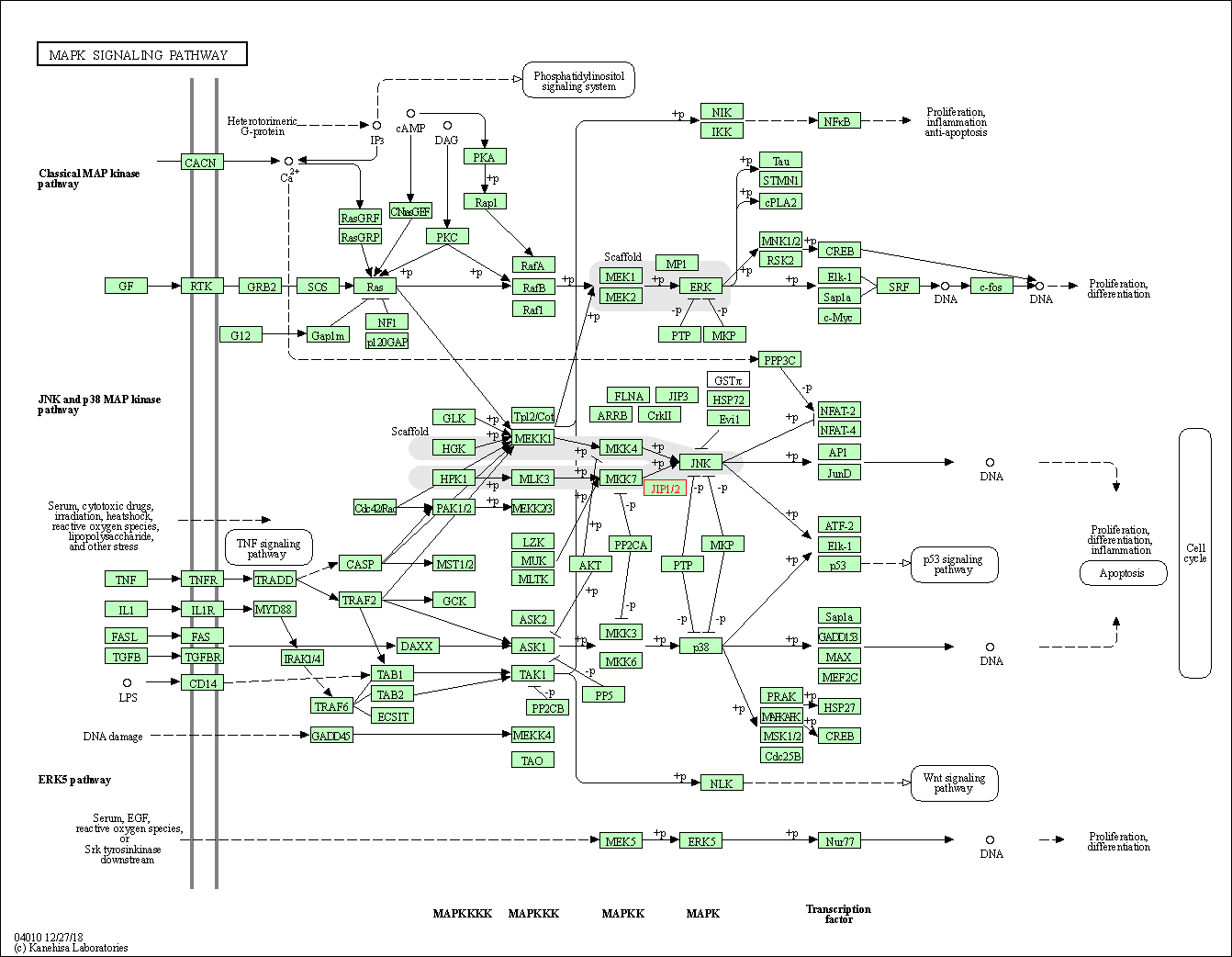Target Information
| Target General Information | Top | |||||
|---|---|---|---|---|---|---|
| Target ID |
T59459
|
|||||
| Target Name |
JNK-interacting protein 1 peptide (pepJIP1)
|
|||||
| Synonyms |
PRKM8IP; Mitogen-activated protein kinase 8-interacting protein 1; JNK-interacting protein 1; JNK MAP kinase scaffold protein 1; JIP1; JIP-1; Islet-brain 1; IB1; IB-1; C-Jun-amino-terminal kinase-interacting protein 1
Click to Show/Hide
|
|||||
| Gene Name |
MAPK8IP1
|
|||||
| Target Type |
Patented-recorded target
|
[1] | ||||
| Function |
Required for JNK activation in response to excitotoxic stress. Cytoplasmic MAPK8IP1 causes inhibition of JNK-regulated activity by retaining JNK in the cytoplasm and inhibiting JNK phosphorylation of c-Jun. May also participate in ApoER2-specific reelin signaling. Directly, or indirectly, regulates GLUT2 gene expression and beta-cell function. Appears to have a role in cell signaling in mature and developing nerve terminals. May function as a regulator of vesicle transport, through interactions with the JNK-signaling components and motor proteins. Functions as an anti-apoptotic protein and whose level seems to influence the beta-cell death or survival response. Acts as a scaffold protein that coordinates with SH3RF1 in organizing different components of the JNK pathway, including RAC1 or RAC2, MAP3K11/MLK3 or MAP3K7/TAK1, MAP2K7/MKK7, MAPK8/JNK1 and/or MAPK9/JNK2 into a functional multiprotein complex to ensure the effective activation of the JNK signaling pathway. Regulates the activation of MAPK8/JNK1 and differentiation of CD8(+) T-cells. The JNK-interacting protein (JIP) group of scaffold proteins selectively mediates JNK signaling by aggregating specific components of the MAPK cascade to form a functional JNK signaling module.
Click to Show/Hide
|
|||||
| UniProt ID | ||||||
| Sequence |
MAERESGGLGGGAASPPAASPFLGLHIASPPNFRLTHDISLEEFEDEDLSEITDECGISL
QCKDTLSLRPPRAGLLSAGGGGAGSRLQAEMLQMDLIDATGDTPGAEDDEEDDDEERAAR RPGAGPPKAESGQEPASRGQGQSQGQSQGPGSGDTYRPKRPTTLNLFPQVPRSQDTLNNN SLGKKHSWQDRVSRSSSPLKTGEQTPPHEHICLSDELPPQSGPAPTTDRGTSTDSPCRRS TATQMAPPGGPPAAPPGGRGHSHRDRIHYQADVRLEATEEIYLTPVQRPPDAAEPTSAFL PPTESRMSVSSDPDPAAYPSTAGRPHPSISEEEEGFDCLSSPERAEPPGGGWRGSLGEPP PPPRASLSSDTSALSYDSVKYTLVVDEHAQLELVSLRPCFGDYSDESDSATVYDNCASVS SPYESAIGEEYEEAPRPQPPACLSEDSTPDEPDVHFSKKFLNVFMSGRSRSSSAESFGLF SCIINGEEQEQTHRAIFRFVPRHEDELELEVDDPLLVELQAEDYWYEAYNMRTGARGVFP AYYAIEVTKEPEHMAALAKNSDWVDQFRVKFLGSVQVPYHKGNDVLCAAMQKIATTRRLT VHFNPPSSCVLEISVRGVKIGVKADDSQEAKGNKCSHFFQLKNISFCGYHPKNNKYFGFI TKHPADHRFACHVFVSEDSTKALAESVGRAFQQFYKQFVEYTCPTEDIYLE Click to Show/Hide
|
|||||
| 3D Structure | Click to Show 3D Structure of This Target | AlphaFold | ||||
| ADReCS ID | BADD_A03440 ; BADD_A05675 ; BADD_A08298 | |||||
| Cell-based Target Expression Variations | Top | |||||
|---|---|---|---|---|---|---|
| Cell-based Target Expression Variations | ||||||
| Different Human System Profiles of Target | Top |
|---|---|
|
Human Similarity Proteins
of target is determined by comparing the sequence similarity of all human proteins with the target based on BLAST. The similarity proteins for a target are defined as the proteins with E-value < 0.005 and outside the protein families of the target.
A target that has fewer human similarity proteins outside its family is commonly regarded to possess a greater capacity to avoid undesired interactions and thus increase the possibility of finding successful drugs
(Brief Bioinform, 21: 649-662, 2020).
Human Tissue Distribution
of target is determined from a proteomics study that quantified more than 12,000 genes across 32 normal human tissues. Tissue Specificity (TS) score was used to define the enrichment of target across tissues.
The distribution of targets among different tissues or organs need to be taken into consideration when assessing the target druggability, as it is generally accepted that the wider the target distribution, the greater the concern over potential adverse effects
(Nat Rev Drug Discov, 20: 64-81, 2021).
Human Pathway Affiliation
of target is determined by the life-essential pathways provided on KEGG database. The target-affiliated pathways were defined based on the following two criteria (a) the pathways of the studied target should be life-essential for both healthy individuals and patients, and (b) the studied target should occupy an upstream position in the pathways and therefore had the ability to regulate biological function.
Targets involved in a fewer pathways have greater likelihood to be successfully developed, while those associated with more human pathways increase the chance of undesirable interferences with other human processes
(Pharmacol Rev, 58: 259-279, 2006).
Biological Network Descriptors
of target is determined based on a human protein-protein interactions (PPI) network consisting of 9,309 proteins and 52,713 PPIs, which were with a high confidence score of ≥ 0.95 collected from STRING database.
The network properties of targets based on protein-protein interactions (PPIs) have been widely adopted for the assessment of target’s druggability. Proteins with high node degree tend to have a high impact on network function through multiple interactions, while proteins with high betweenness centrality are regarded to be central for communication in interaction networks and regulate the flow of signaling information
(Front Pharmacol, 9, 1245, 2018;
Curr Opin Struct Biol. 44:134-142, 2017).
Human Similarity Proteins
Human Tissue Distribution
Human Pathway Affiliation
Biological Network Descriptors
|
|
|
Note:
If a protein has TS (tissue specficity) scores at least in one tissue >= 2.5, this protein is called tissue-enriched (including tissue-enriched-but-not-specific and tissue-specific). In the plots, the vertical lines are at thresholds 2.5 and 4.
|

| KEGG Pathway | Pathway ID | Affiliated Target | Pathway Map |
|---|---|---|---|
| MAPK signaling pathway | hsa04010 | Affiliated Target |

|
| Class: Environmental Information Processing => Signal transduction | Pathway Hierarchy | ||
| Degree | 12 | Degree centrality | 1.29E-03 | Betweenness centrality | 2.97E-04 |
|---|---|---|---|---|---|
| Closeness centrality | 2.33E-01 | Radiality | 1.41E+01 | Clustering coefficient | 2.27E-01 |
| Neighborhood connectivity | 2.83E+01 | Topological coefficient | 1.07E-01 | Eccentricity | 12 |
| Download | Click to Download the Full PPI Network of This Target | ||||
| Target Regulators | Top | |||||
|---|---|---|---|---|---|---|
| Target-regulating microRNAs | ||||||
| Target-interacting Proteins | ||||||
| Target Affiliated Biological Pathways | Top | |||||
|---|---|---|---|---|---|---|
| KEGG Pathway | [+] 1 KEGG Pathways | + | ||||
| 1 | MAPK signaling pathway | |||||
| References | Top | |||||
|---|---|---|---|---|---|---|
| REF 1 | c-Jun N-terminal kinase inhibitors: a patent review (2010 - 2014).Expert Opin Ther Pat. 2015;25(8):849-72. | |||||
If You Find Any Error in Data or Bug in Web Service, Please Kindly Report It to Dr. Zhou and Dr. Zhang.

